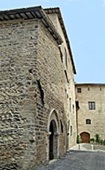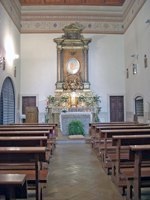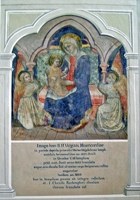

San Sebastiano (1476-7) Ospedale della Trinità (1374)
Ospedale della Trinità (14th century)
This hospice, which belonged to the the Compagnia della Croce, seems to have provided an urban base for the dissident Franciscan followers of Angelo Clareno from San Lorenzo di Rapecchiano (between Spello and Foligno). These so-called “fraticelli” were recognised as an orthodox Franciscan congregation only in 1406. In 1447, the orthodox Clareni of Camerino, Foligno and Spoleto held their annual meeting here (actum Foligno, in domibus fraternitatis S. Augustini, iuxta hospitale dicte fraternitatis). From this it seems that the Compagnia della Croce was also known as the Fraternita di Sant’ Agostino.
The Blessed Tomasuccio lived and worked here from 1377 until his death late 14th or early 15th century. The chapel in which he died was demolished in the 1970s. His relics were subsequently moved to Sant’ Agostino, where an altar was built in his honour at some time before 1444.
The confraternity built the church to the left of the hospice during an epidemic of plague in 1476-7 and dedicated it to the plague saint, St Sebastian.
The complex was abandoned in the 16th century.
Blessed Tomasuccio da Foligno (ca. 1626)
This panel depicting the standing Blessed Tomasuccio, which is attributed to Noel Quillerier, came from the now-demolished chapel of the Ospedale della Trinità in which the Blessed Tomasuccio died. [Where is it now ??]
Ursuline Period (1600-1867)
In 1600, the Ursuline Paola da Foligno founded a nunnery here dedicated to St Ursula, at which point the church became known as the Oratorio di Madre Paola. The congregation was suppressed in 1867.
Santa Caterina Nuova
In 1887, the complex passed to a community of Poor Clares that came originally from Santa Caterina Vecchia, and the church and nunnery received the current dedication.
Interior of the Church

The church is in two parts:
-
✴the public space, illustrated here; and
-
✴the nuns' choir, behind the grill on the left.
Madonna del Riscatto (15th century ?)

The fresco depicts the Madonna and Child enthroned in a Gothic tabernacle with two grieving angels clutching the columns.



